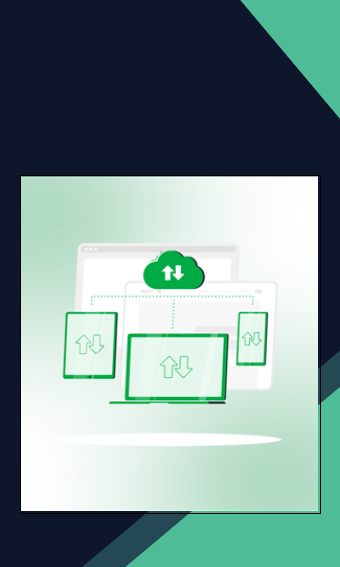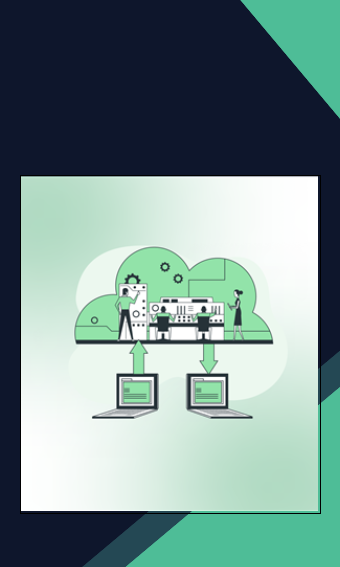Quick Summary :- The demand for multi-cloud architecture has been on the rise in recent times. It allows organizations to make use of services from different cloud providers and get maximum benefits for their business. However, the selection of the best multi-cloud architecture design can be challenging. In this article, you will explore the 7 multi-cloud architecture designs for an effective cloud strategy.
Did you know that 90 percent of large organizations already leverage multi-cloud architectures? Yes, you read it right!
As enterprises transform digitally, the workflow increases. So, the breadth of their digital infrastructure, software applications, and data also expands. To lower the software development costs and leverage the best cloud development services, organizations take advantage of the multiple cloud offerings.
Digital transformation of organizations is taking place at a blazing speed. Therefore, the adoption of private and public clouds is on the rise. However, the lack of proper understanding of cloud technology often remains a major challenge among the CTOs of enterprises.
This article will shed light on the concept of multi-cloud architecture and its different designs. Let’s dive in!
An Overview of Basic Cloud Architecture

As the name suggests, it basically consists of three tiers, namely application server, load balance server, and database server. For each of the tiers, you will find a dedicated server.
In order to test the interactivity between different tiers of applications, a non-redundant architecture is used. It consists of only one server for individual tiers. However, you can leverage a redundant 3-tier architecture in the production environment.
While the non-redundant architecture is a basic one, additional servers can be used based on the application type. Want to understand the concept better? In that case, let’s take the instance of Netflix for better understanding.
Have you ever thought about how Netflix can effectively manage the vast collection of videos and deliver excellent streaming experiences to the users? Well, the answer is its multiple data centres that are situated strategically across the globe. As a result, providing a faster viewing experience becomes simple and easy.
One of the most appealing features of the cloud is the horizontal auto scaling. It offers you the flexibility to lower or increase the number of servers as per the requirement. However, to perform this task efficiently, you would need a load balancer.
Multi-Cloud Strategy
Are you wondering what the multi-cloud strategy actually is? Well, it refers to the simultaneous use of two or more cloud services. It may include Google Cloud, Azure, AWS, or other cloud services.
For instance, a company can leverage Google Cloud in order to serve the US servers. On the other hand, the same firm can utilize Microsoft Azure for its Europe customers. Similarly, you can use Cognito for effective user management while using Azure SQL for the databases.
The multi-cloud strategy allows you to run apps on different clouds. The production environment can run on one cloud while the test and development environments can run on another cloud.
However, multi-cloud management is something different. It is all about optimizing the cloud deployment cost. In order to make the most of the multi-cloud strategy, knowing how to monitor and manage cloud deployment and its associated costs is crucial.
Are you thinking about when to leverage the multi-cloud strategy? If so, it can prove to be effective in the following cases.
- There are regulation limits in specific countries for data storage.
- The data centers are located far away from the users or widely distributed across the globe.
- Lack of resiliency of the cloud-based applications, thereby affecting
- disaster recovery.
- Environments in which public cloud is used along with on-premise resources.
Explore the Top 7 Multi-Cloud Architecture Designs
Now that you have a comprehensive idea of the multi-cloud architecture, it is time to explore the prominent designs. Want to build reliable and scalable apps? If yes, choosing the right multi-cloud architecture designs matters a lot.
Below is a complete list of multi-cloud architecture designs you must know. Let’s discover!
1. Cloudification

Benefits: This multi-cloud architecture helps improve the availability of the applications. Moreover, re-hosting in several cloud platforms aids in minimizing the risk of vendor lock-in.
2. Multi-Cloud Refactor

A point to note here is that the re-architecting must be done as fine-grained components. It allows independent optimization of the deployment of high-usage components. Selecting the parallel design ensures better throughput to multi-cloud platforms.
As a result, it can optimize the performance and scalability of the applications. Moreover, it improves agility and helps respond to IT and business needs effectively.
Benefits: Availability of a wide range of multi-cloud deployment options, optimal performance and scalability, and agility to effectively respond to IT and business needs.
Drawbacks: Modernization of the on-premise application is only possible in isolation. The core aim of performing modernization is to meet the critical technical requirements. However, it is vital to re-evaluate the component architecture owing to the multi-cloud environment.
3. Multi-Cloud Relocation

Benefits: The architecture improves the availability of applications as they are re-hosted in multiple cloud platforms. Moreover, it helps in avoiding vendor lock-in.
4. Multi-Cloud Rebinding

Benefits: It helps transform unhealthy services into healthy ones. The architecture design can maximize the responsiveness of the returning system and ensure optimum delivery of traffic.
5. Multi-Application Modernization

Benefits: The architecture design provides consistent rules and information for shared components. Moreover, it significantly lowers the maintenance and operation costs for the shared components.
Drawbacks: The absence of business commitment is a major challenge of this architecture.
6. Multi-Cloud Rebinding with Cloud Brokerage

Benefits: It allows the unhealthy services to become healthy again. It enhances the responsiveness of the returning system and ensures traffic delivery.
Drawbacks: The architecture may not ensure seamless failover. Moreover, downtime can be an issue.
7. Public-Private Multi-Cloud Architecture

Hybrid Cloud vs. Multi Cloud

Wondering how they are different? In this section, you will explore more details about multi cloud and hybrid cloud technology. Let’s dive in!
Hybrid Cloud
A hybrid cloud refers to a combination of private and public clouds connecting the public cloud to your on-premise system. It is designed in such a manner that both the cloud work together to perform a single task. Hybrid cloud basically optimizes the workload and ensures that it runs in the right environment at the right time.
A hybrid cloud allows enterprises to gain access to the highly elastic resources from the selected providers. It allows efficient management and storage of additional workload during peak hours. However, it can also be used for general applications.
A point to note here is that all the critical stuff continues to remain at the on-premise infrastructure. Wondering why? Well, it is because of the security and privacy regulations.
Why Leverage Hybrid Cloud?
In some cases, organizations need a mix of a public and private cloud. The ultimate goal is to make the most of the unique benefits offered by the combination.
Cloudbusting is a popular option among organizations. It is generally used when the private cloud reaches its threshold level and the application workloads rely on a public cloud owing to the need for additional resources.
However, enterprises can also leverage the public cloud for new and untested applications. Wondering why? Well, it is because launching an application on a private cloud requires a lot of capital investment.
So, only when you have a steady-state workload pipeline and are ready to run an application, it is wise to get the app to your on-premise system. In addition to that, organizations can leverage hybrid cloud to promote better disaster recovery and high availability.
Still, wondering how a hybrid cloud can be useful in the disaster recovery situation? In this scenario, enterprises can choose to use the private cloud for the production environment and the public cloud for its recovery environment.
The organizational data are replicated across the public cloud. However, a point to note here is that all the other resources are non-functional until and unless they are required.
Another benefit of using a hybrid cloud is that it allows maximum agility and meets the growing organizational needs. Moreover, it offers the essential infrastructure for the automation of IT operations to enhance the overall user experience.
Multi Cloud
Now that you have clarity about the hybrid cloud architecture, it is time to move on to multi-cloud. In simple terms, multi-cloud refers to the deployment of more than one cloud of the same type. It can be either a private or public cloud offered by different cloud providers.
You must be wondering whether hybrid and multi-cloud are mutually expensive or not. Well, they aren’t mutually exclusive. You can use both approaches simultaneously. Using both hybrid and multi-cloud approaches allows organizations to enhance their performance and improve security.
It is quite common to get confused between multi-tenant architecture and multi-cloud architecture. Many assume that they both are the same. However, it isn’t true!
We have already discussed the multi-cloud architecture. When it comes to multi-tenant architecture, it refers to an architecture in which only one instance of software runs on a single server. However, it can serve a number of tenants.
Also Read – Software Architecture Patterns You Must Know About
Why Leverage Multi-Cloud?
The multi-cloud approach comes with several use cases for the organizations. It allows the IT teams of enterprises to increase their control over data and workload. Moreover, it can also boost flexibility.
The flexible cloud environment of multi-cloud enables organizations to meet their unique application or workload requirements. It can easily address all your commercial and technical needs.
Moreover, organizations can even expect surprising geographical advantages. It can help address the app latency issues efficiently. Certain organizations may also use specific cloud providers for a very short period of time in order to attain their short-term goals. Once achieved, they may stop using the services of the cloud provider.
Also, other issues that the multi-cloud approach can resolve include the potential cloud provider outages and vendor lock-in concerns.
Tips for Effective Management of Multi-Cloud Environment
No doubt, the multi-cloud architecture comes with a lot of benefits. However, there are certain drawbacks too.
Wondering what are the main challenges? Well, it includes management issues, costs, resources, complexity, and expertise. The management problem seems to be the most prominent one.
Let’s take the help of a situation in order to understand it better.
An organization runs a workload that needs a large pool of networking and storage resources on a private cloud. There is another workload that runs on Amazon’s service. Moreover, there is yet another one running on Microsoft’s service.
Now you need to manage multiple clouds. How is it possible to manage them effectively?
In order to create an effective multi-cloud environment, there are certain things you need to factor in. Some of the prominent ones are outlined below.
- Having multi-cloud providers can accelerate low-level monitoring and maintenance tasks. Therefore, automating them is better.
- Evaluate your entire network and determine the services of specific cloud providers that meet your unique requirements the best. It can help avoid poor utilization of the available resources and minimize system complexity.
- Identify the different applications in your organization that are ideal for the multi-cloud environment. The cloud-native apps are quite different from the traditional apps. They are service-oriented, flexible, and consist of a collection of services and containers.
- Leverage the integrated data center management system that is meant for virtual environments. It can enable you to conveniently develop systems in which your network, server, operations, storage, applications, and security teams work as per the common goals.
- Prioritize policy standardization that is applicable to each cloud environment. The policies can cover several areas such as regulations and compliance, workloads, data storage, virtual servers, traffic flows, reporting, and security.
Benefits of Using Multi-Cloud Architecture
Are you still not convinced about leveraging the multi-cloud architecture? In that case, knowing the benefits is a must. Read on to explore the most popular benefits.
Data Management
In any organization, you will find a wide range of data types. For instance, some database needs hot storage. It consists of the data that are frequently accessed by the team members.
However, there are other databases that require cold storage. It mainly contains data that are not accessed on a regular basis.
So, instead of storing all your data in a single cloud, you can diversify it. As a result, you can take advantage of the best services for effective functioning.
Low Latency
Imagine a situation in which the users of an application are situated at different geographical locations worldwide. However, the transfer of data takes place from a single data center only. Such a situation can slow down the response time and affect the overall experience of users.
As data has to pass through several nodes in order to reach the end-users, the delays can be more. This delay is known as latency. It is common in cloud services where the servers are located in distant places.
However, that is not the case in multi-cloud architecture. In this environment, cloud architects can easily deploy data centers in multiple regions as per the user locations. As a result, the closest data center can provide the requested data to the end-users without the need for excess server hopping.
This feature of multi-cloud architecture especially proves to be beneficial for large, global organizations. It allows them to serve data across wider geographical locations and enhance the experience of the users.
Disaster Recovery
Disasters can happen at any time and significantly impact organizations. So, it is quite risky to store all organizational resources in a single cloud platform. A potential cyber attack or any other disaster can result in the loss of all data and bring the operations of the organizations to a complete pause.
To avoid such a situation, it is wise to rely on the multi-cloud architecture. It ensures optimum protection of the different resources of the company against such attacks. As there are several clouds available, one cloud can manage the workloads when another goes down.
Better Cost Optimization
Before you opt for the multi-cloud architecture, it is best to conduct a performance analysis. Evaluate the performance of workloads present on-premises or on the cloud.
Comparing them will enable you to get an idea of the best options that can effectively meet your specific workload performance needs at budget-friendly prices. As a result, it can help in bringing down your overall costs significantly.
Avoids Vendor Lock-in
Vendor lock-in is a common problem for a number of organizations. However, the multi-cloud architecture enables organizations to effectively choose the best service from different cloud platforms. As a result, they can build a custom infrastructure as per their unique goals.
No longer do you have to manage your business processes according to the setup and execution of the cloud service providers. Instead, you can look for various providers and opt for those services that match your business needs.
Conclusion
Adopting multi-cloud architecture has become the need of the hour. It empowers businesses to build reliable and secure cloud environments to better serve the end-users. Moreover, it can tackle several challenges like app sprawl, migration, compliance, and security and ensure better outcomes.
Whether there are different architecture designs available, choosing the right one is important. Now that you have a clear idea about the various multi-cloud architecture designs, it is time to select and implement the best one. Make sure to consider your unique business needs and budget to make the right choice.
Why Choose eSparkBiz for Multi-Cloud Architecture?
If you planning to opt for multi-cloud architecture and looking for experts in the domain, eSparkBiz is the name you can trust. We have been functioning in the industry for long 15+ years. Our rich experience enables us to stand out in the crowd and deliver flawless services.
The main aim of eSparkBiz is to bring technological solutions to clients across the globe and enable them to succeed on every front. With flexible business models, the experts focus on meeting the unique requirements of companies.
eSparkBiz has a team of 400+ dedicated development staff with having wealth of experience and expertise in the field. We offer our services across 20+ countries around the globe. Our high-quality and timely services have enabled us to maintain a client retention rate of 95%.
Collaborate with the professional experts of eSparkBiz today and discuss your unique needs. We are ready to deliver the best solutions and services to our valuable clients.



